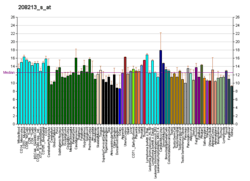KCNAB1
Voltage-gated potassium channel subunit beta-1 is a protein that in humans is encoded by the KCNAB1 gene.[5][6][7]
Potassium channels represent the most complex class of voltage-gated ion channels from both functional and structural standpoints. Their diverse functions include regulating neurotransmitter release, heart rate, insulin secretion, neuronal excitability, epithelial electrolyte transport, smooth muscle contraction, and cell volume. Four sequence-related potassium channel genes - shaker, shaw, shab, and shal - have been identified in Drosophila, and each has been shown to have human homolog(s). This gene encodes a member of the potassium channel, voltage-gated, shaker-related subfamily. This member includes three distinct isoforms that are encoded by three alternatively spliced transcript variants of this gene. These three isoforms are beta subunits, which form heteromultimeric complex with alpha subunits and modulate the activity of the pore-forming alpha subunits.[7]
See also
References
- 1 2 3 GRCh38: Ensembl release 89: ENSG00000169282 - Ensembl, May 2017
- 1 2 3 GRCm38: Ensembl release 89: ENSMUSG00000027827 - Ensembl, May 2017
- ↑ "Human PubMed Reference:".
- ↑ "Mouse PubMed Reference:".
- ↑ Schultz D, Litt M, Smith L, Thayer M, McCormack K (Mar 1997). "Localization of two potassium channel beta subunit genes, KCNA1B and KCNA2B". Genomics. 31 (3): 389–91. doi:10.1006/geno.1996.0065. PMID 8838324.
- ↑ England SK, Uebele VN, Kodali J, Bennett PB, Tamkun MM (Jan 1996). "A novel K+ channel beta-subunit (hKv beta 1.3) is produced via alternative mRNA splicing". J Biol Chem. 270 (48): 28531–4. doi:10.1074/jbc.270.48.28531. PMID 7499366.
- 1 2 "Entrez Gene: KCNAB1 potassium voltage-gated channel, shaker-related subfamily, beta member 1".
Further reading
- England SK, Uebele VN, Shear H, et al. (1995). "Characterization of a voltage-gated K+ channel beta subunit expressed in human heart". Proc. Natl. Acad. Sci. U.S.A. 92 (14): 6309–13. doi:10.1073/pnas.92.14.6309. PMC 41507. PMID 7603988.
- McCormack K, McCormack T, Tanouye M, et al. (1995). "Alternative splicing of the human Shaker K+ channel beta 1 gene and functional expression of the beta 2 gene product". FEBS Lett. 370 (1–2): 32–6. doi:10.1016/0014-5793(95)00785-8. PMID 7649300.
- Majumder K, De Biasi M, Wang Z, Wible BA (1995). "Molecular cloning and functional expression of a novel potassium channel beta-subunit from human atrium". FEBS Lett. 361 (1): 13–6. doi:10.1016/0014-5793(95)00120-X. PMID 7890032.
- Morales MJ, Castellino RC, Crews AL, et al. (1995). "A novel beta subunit increases rate of inactivation of specific voltage-gated potassium channel alpha subunits". J. Biol. Chem. 270 (11): 6272–7. doi:10.1074/jbc.270.11.6272. PMID 7890764.
- McCormack T, McCormack K (1995). "Shaker K+ channel beta subunits belong to an NAD(P)H-dependent oxidoreductase superfamily". Cell. 79 (7): 1133–5. doi:10.1016/0092-8674(94)90004-3. PMID 8001150.
- Nakahira K, Shi G, Rhodes KJ, Trimmer JS (1996). "Selective interaction of voltage-gated K+ channel beta-subunits with alpha-subunits". J. Biol. Chem. 271 (12): 7084–9. doi:10.1074/jbc.271.12.7084. PMID 8636142.
- Leicher T, Roeper J, Weber K, et al. (1997). "Structural and functional characterization of human potassium channel subunit beta 1 (KCNA1B)". Neuropharmacology. 35 (7): 787–95. doi:10.1016/0028-3908(96)00133-5. PMID 8938711.
- Hanada T, Lin L, Chandy KG, et al. (1997). "Human homologue of the Drosophila discs large tumor suppressor binds to p56lck tyrosine kinase and Shaker type Kv1.3 potassium channel in T lymphocytes". J. Biol. Chem. 272 (43): 26899–904. doi:10.1074/jbc.272.43.26899. PMID 9341123.
- Leicher T, Bähring R, Isbrandt D, Pongs O (1999). "Coexpression of the KCNA3B gene product with Kv1.5 leads to a novel A-type potassium channel". J. Biol. Chem. 273 (52): 35095–101. doi:10.1074/jbc.273.52.35095. PMID 9857044.
- Suzuki Y, Ishihara D, Sasaki M, et al. (2000). "Statistical analysis of the 5' untranslated region of human mRNA using "Oligo-Capped" cDNA libraries". Genomics. 64 (3): 286–97. doi:10.1006/geno.2000.6076. PMID 10756096.
- Kuryshev YA, Wible BA, Gudz TI, et al. (2001). "KChAP/Kvbeta1.2 interactions and their effects on cardiac Kv channel expression". Am. J. Physiol., Cell Physiol. 281 (1): C290–9. doi:10.1152/ajpcell.2001.281.1.c290. PMID 11401852.
- Strausberg RL, Feingold EA, Grouse LH, et al. (2003). "Generation and initial analysis of more than 15,000 full-length human and mouse cDNA sequences". Proc. Natl. Acad. Sci. U.S.A. 99 (26): 16899–903. doi:10.1073/pnas.242603899. PMC 139241. PMID 12477932.
- Nie DY, Zhou ZH, Ang BT, et al. (2003). "Nogo-A at CNS paranodes is a ligand of Caspr: possible regulation of K+ channel localization". EMBO J. 22 (21): 5666–78. doi:10.1093/emboj/cdg570. PMC 275427. PMID 14592966.
- Ota T, Suzuki Y, Nishikawa T, et al. (2004). "Complete sequencing and characterization of 21,243 full-length human cDNAs". Nat. Genet. 36 (1): 40–5. doi:10.1038/ng1285. PMID 14702039.
- Gerhard DS, Wagner L, Feingold EA, et al. (2004). "The Status, Quality, and Expansion of the NIH Full-Length cDNA Project: The Mammalian Gene Collection (MGC)". Genome Res. 14 (10B): 2121–7. doi:10.1101/gr.2596504. PMC 528928. PMID 15489334.
- Kimura K, Wakamatsu A, Suzuki Y, et al. (2006). "Diversification of transcriptional modulation: Large-scale identification and characterization of putative alternative promoters of human genes". Genome Res. 16 (1): 55–65. doi:10.1101/gr.4039406. PMC 1356129. PMID 16344560.
External links
- KCNAB1+protein,+human at the US National Library of Medicine Medical Subject Headings (MeSH)
This article incorporates text from the United States National Library of Medicine, which is in the public domain.






